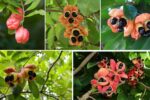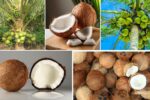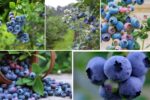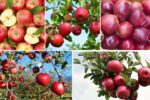Intro: Designing a garden in arid regions or places with water restrictions doesn’t mean sacrificing beauty or greenery. With the right selection of water-retaining, drought-tolerant plants, you can create a thriving, eye-catching outdoor space that requires minimal watering. These stunning desert plants are not only resilient but also add unique textures, shapes, and colors to your garden. Here are ten striking options perfect for your low-water landscaping needs.
1. Agave Americana (Century Plant)

Agave Americana, commonly known as the Century Plant, is a dramatic succulent with bold, spiky leaves edged with sharp spines. Native to Mexico and the southern United States, this plant thrives in hot, dry conditions and can go long periods without water. Its large, sculptural form makes it a striking focal point in any xeriscape or desert-themed garden. Besides being drought-tolerant, Agave Americana requires very little maintenance, making it ideal for those seeking a low-effort, high-impact plant.
2. Aloe Vera

Best known for its medicinal properties, Aloe Vera is also an excellent addition to low-water gardens. This succulent features fleshy, serrated leaves filled with a soothing gel. Its ability to store water in its leaves allows it to withstand prolonged dry spells. Aloe Vera prefers well-drained soil and full sun but can tolerate partial shade. During the summer, it produces beautiful spikes of tubular yellow or orange flowers, adding a pop of color to your drought-tolerant garden.
3. Echeveria

Echeverias are beloved for their charming, rose-like rosettes and wide range of colors, from pale green to deep purple. Native to semi-desert areas of Central America, these succulents are masters at conserving water. Their thick, fleshy leaves help them survive extended dry periods. Echeverias thrive in sunny, well-drained locations and are perfect for container gardens, rockeries, or borders. They also produce delicate, bell-shaped flowers on tall stalks, enhancing their visual appeal.
4. Desert Marigold (Baileya multiradiata)

The Desert Marigold is a hardy, drought-resistant perennial that offers cheerful splashes of bright yellow throughout the growing season. Its silvery-green foliage helps reflect sunlight and conserve water, while its daisy-like blooms attract pollinators like bees and butterflies. Native to the southwestern United States, this plant requires minimal water once established and flourishes in poor, sandy soils. It’s perfect for adding vibrant color to arid landscapes without the need for frequent irrigation.
5. Ocotillo (Fouquieria splendens)

Ocotillo is an iconic desert plant known for its tall, slender, spiny stems that burst into vivid red tubular flowers after rain. Despite its dramatic appearance, Ocotillo is incredibly water-efficient. It can remain leafless during drought and rapidly sprout leaves following rainfall. This native of the American Southwest adds vertical interest to low-water gardens and is especially effective when planted en masse or used as a striking accent plant against a rocky backdrop.
6. Red Yucca (Hesperaloe parviflora)

Red Yucca, despite its name, isn’t a true yucca but shares many of its drought-resistant traits. It features narrow, arching, blue-green leaves and produces tall spikes of tubular coral-red or pink flowers that attract hummingbirds. Hardy and adaptable, Red Yucca tolerates extreme heat and poor soil conditions, making it a staple in desert landscapes. It requires little maintenance and minimal watering once established, providing year-round structure and seasonal color to low-water gardens.
7. Prickly Pear Cactus (Opuntia)

The Prickly Pear Cactus is a classic choice for water-conserving gardens. Recognizable by its flat, paddle-shaped pads and vibrant seasonal blooms, it thrives in hot, dry environments. Its thick pads store water, enabling it to survive extended droughts. Many varieties also produce edible fruits known as “tunas.” Prickly Pear Cactus requires well-drained soil and full sun, making it an attractive, practical option for arid garden designs.
8. Golden Barrel Cactus (Echinocactus grusonii)

The Golden Barrel Cactus is a showstopper in any desert garden with its spherical form and bright, golden spines. Native to central Mexico, this slow-growing cactus stores water within its thick, ribbed body, allowing it to endure dry conditions. It prefers sunny locations and gritty, well-drained soil. Though it rarely flowers in cooler climates, in hot regions, it produces small yellow blooms, adding seasonal interest to xeriscapes and rock gardens.
9. California Poppy (Eschscholzia californica)

The California Poppy is a cheerful, drought-tolerant wildflower known for its silky, cup-shaped blooms in brilliant shades of orange and yellow. Native to the western United States, it thrives in poor, dry soils and requires minimal water once established. Besides its striking appearance, the California Poppy self-seeds easily, providing ongoing beauty without constant replanting. Its bright flowers attract pollinators, making it a beneficial addition to eco-friendly, low-water landscapes.
10. Parry’s Agave (Agave parryi)

Parry’s Agave is a compact, rosette-forming succulent with thick, blue-gray leaves edged with sharp teeth. Native to the deserts of Arizona and New Mexico, it’s perfectly adapted to survive arid conditions with minimal watering. Its striking form and symmetrical foliage make it a beautiful feature plant in rock gardens or xeriscapes. Occasionally, mature plants produce a tall flower spike bearing yellow blooms, after which the main plant dies, leaving behind new offshoots for continued garden interest.





